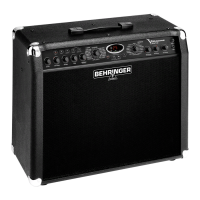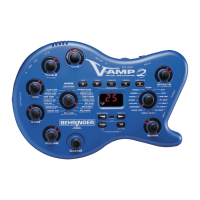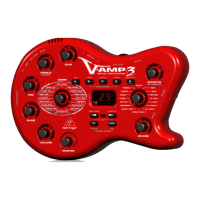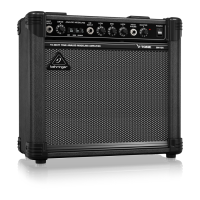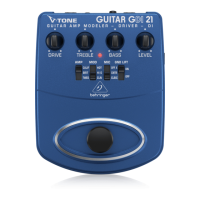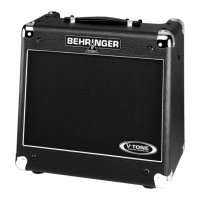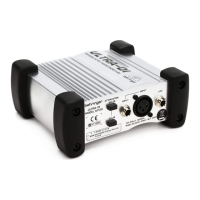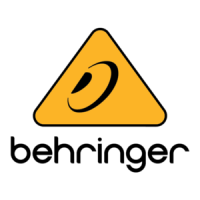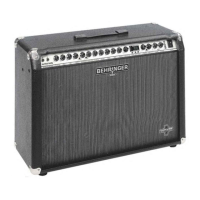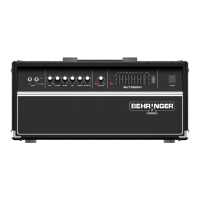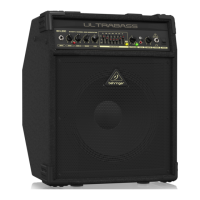7$3NH\
(
I
I
H
F
W
1
R
(IIHFW
())(&76
FRQWURO
Table 6.1: Effects and MIDI controllers
+ Table 6.1 shows the MIDI controllers for the
corresponding parameters. The settings are made
via MIDI. A detailed list of all controllable MIDI
parameters will be available free of charge on the
BEHRINGER internet site: www.behringer.com.
6.1 Wah Wah
The MIDI function enables you to use an additional Wah Wah
effect. The optimum control of this effect is achieved by using a
MIDI foot controller with expression pedal, e.g. our BEHRINGER
MIDI FOOT CONTROLLER FCB1010.
+ Adjust the filter characteristic and grade in the DRIVE
menu by simultaneously pressing TAP and turning
the EFFECTS control (see also B).
6.2 Effect descriptions
The following section contains short descriptions of the effects
that can be produced using the multi-effects processor.
6.2.1 Reverb and delay algorithms
REVERB: Reverb is still the most important effect for mixing or
live performance. Thats why we at BEHRINGER make a point of
giving you as many as nine different reverb programs so that
you can use the most suitable reverb program for any situation.
The reverb effect can be added separately to all the other effects
(see chapter 6.2).
ECHO: Echo is similar to the stereo delay effect in that it is a
delayed repetition of the input signal. The main difference is that
the high-frequency content of the repeated signals steadily
decreases. This simulates a tape delay used in the pre-digital
era, producing a vintage sound. In addition, the reflections are
routed in turn to the left and right channels, creating a quasi-
stereo effect.
DELAY: This algorithm delays the input signal, with different
tempo settings producing interesting delay effects. U2s The
Edge has impressively demonstrated the potential of this effect.
PING PONG: A delay effect that changes position in the stereo
image.
6.2.2 Modulation effects
PHASER: The principle behind the phaser is that a second,
phase-shifted signal is added to the audio signal. This makes the
sound richer and, above all, livelier. This effect is popular among
guitarists and keyboard players alike, but was also used
extensively in the 70s with other instruments, such as electric
pianos. Depending on how you set it, the phaser can be used to
produce slightly modulating or strongly alienating effects.
FLANGER: This effect is self-explanatory. Originally, the flanger
effect was produced by running two synchronized tape
recorders at the same time. The same signals (e.g. a guitar solo)
were recorded on both machines. Putting a finger on the left reel
of one of the machines caused it and the speed of the playback
to slow. The resulting delay produced phase shifts of the signals.
CHORUS: This effect adds a slightly modulated off-key element
to the original signal, thus creating a pleasant floating effect
through variations in pitch.
6.2.3 Combinations of effect algorithms
(multi-effects programs)
PHASER & DELAY: Phaser and delay combined.
FLANGER & DELAY: Here the input signal is delayed and
processed with a pronounced wave-like effect. It is particularly
effective for highlighting single notes, but can also be used to
make solos more interesting.
CHORUS & DELAY: This algorithm combines signal delay with
the popular chorus effect.
CHORUS & COMP: Incredible sustain effects can be produced
with the compressor. This is especially useful for sustaining
individual guitar notes. Combined with chorus, it can make the
audio signal extremely dense.
6.2.4 Special effects
COMPRESSOR: A compressor limits the dynamic range of the
audio material, thus producing audible and creative sound effects.
Pronounced use of the compressor (using the EFFECTS control)
allows you to compress the overall dynamic range of the material.
AUTO WAH: The legendary wah-wah effect owes its fame
mainly to Jimi Hendrix. Describing it is certainly more difficult than
simply listening to Hendrix using it on Voodoo Chile. In American
funk music of the 70s you can hear auto-wah effects used in a
variety of applications. The auto-wah alters its filter frequency
automatically depending on the signals magnitude, rather than
being controlled by the position of a pedal.
TREMOLO: Simulates the classic Fender Tremolo. It has
returned to popularity with trip-hop.
ROTARY: This is the quintessential simulation of the classic
organ effect normally produced by speakers rotating at slow or
fast speed in an extremely heavy speaker cabinet. This effect
uses the physical principle of the Doppler effect to modulate the
sound.
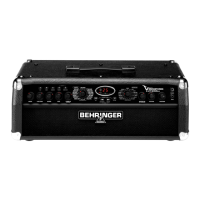
